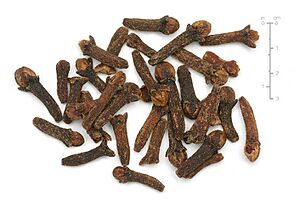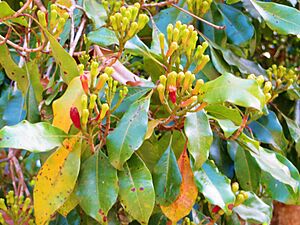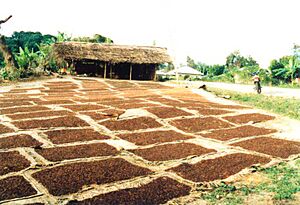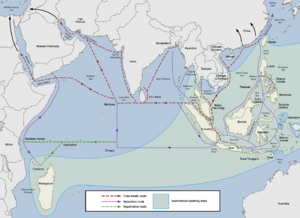Clove facts for kids
Quick facts for kids Clove |
|
|---|---|
 |
|
| Scientific classification | |
| Genus: |
Syzygium
|
| Species: |
aromaticum
|
| Synonyms | |
|
|
Cloves are the dried flower buds of a special tree called Syzygium aromaticum. This tree belongs to the Myrtaceae family. Cloves originally came from the Maluku Islands (also known as the Spice Islands) in Indonesia.
Today, cloves are a popular spice used all over the world. They add a special flavoring or smell to many things. You can find cloves in products like toothpaste, soaps, and even cosmetics. Because different countries harvest cloves at different times, you can find them available all year long.
Contents
What is a Clove?
The word clove first came into English in the 1400s. It comes from an old French word that means "nail." If you look at a dried clove, it really does look like a small nail!
How Cloves Grow
The clove tree is an evergreen tree, meaning it stays green all year. It can grow quite tall, up to 8 to 12 meters (about 26 to 39 feet). It has big leaves and bright red flowers that grow in groups.
The flower buds start out pale, then turn green, and finally become a bright red when they are ready to be picked. When harvested, cloves are usually about 1.5 to 2 centimeters (about 0.6 to 0.8 inches) long. Each clove has a long base and four small, unopened petals that form a tiny ball at the top.
Sometimes you might hear about different types of cloves:
- Mother cloves are the ripe fruits of the clove tree. They are brown and oval-shaped.
- Blown cloves are flowers that have opened up and lost their petals and other parts.
- Exhausted cloves are cloves that have had most of their oil removed. They are darker and don't have much smell or flavor left.
How We Use Cloves
Cloves are used in cooking in many parts of the world, including Asia, Africa, and the Middle East. They add a unique flavor to meats, like baked ham, and to curries and marinades. You can also use them with fruits like apples, pears, and rhubarb.
Cloves are great for adding flavor to hot drinks, often mixed with lemon and sugar. They are also a key part of many spice blends, like pumpkin pie spice. In Mexican cuisine, cloves are known as clavos de olor and are often used with cumin and cinnamon.
The main flavor in cloves comes from a chemical called eugenol. You only need a small amount of cloves to get a lot of flavor. Cloves go well with other spices like cinnamon, allspice, and vanilla. They also pair nicely with red wine, onion, and citrus peel.
Other Uses for Cloves
Besides cooking, cloves have other interesting uses:
- In some places, cloves are added to betel quids to make them smell better when chewed.
- In Indonesia, cloves are used in a type of cigarette called kretek.
- Clove essential oil can help stop mold from growing on some foods.
- It can also help protect wood, which is useful for preserving old buildings or artifacts.
- You can make a sweet-smelling pomander by sticking cloves into an orange. In Victorian England, giving a clove pomander as a gift showed warm feelings.
Cloves and Health
It's important to know that the US Food and Drug Administration (FDA) has not approved cloves for any medical purpose. If someone takes cloves orally (by mouth), especially in large amounts, it can cause problems. This is especially true for people with liver disease, blood clotting issues, immune system problems, or food allergies.
However, cloves have been used in traditional medicine for a long time. Clove oil is sometimes used to help with toothache pain. Some studies suggest that the eugenol in clove oil might help with pain. Clove essential oil may also help stop the growth of certain bacteria.
It is not proven if cloves can lower blood sugar levels. Clove essential oil is also sometimes used in aromatherapy for its pleasant smell. Always talk to a doctor before using cloves for any health reason.
History of Cloves
For a long time, cloves only grew on a few islands in the Moluccas (Spice Islands), like Bacan and Ternate.
Cloves were first traded by the Austronesian peoples around 1500 BC. This early trade network later became part of the famous Spice trade. Today, a lot of clove farming happens on the east coast of Madagascar.
Archaeologists have found cloves in ancient sites. For example, cloves were found in a burned house in Terqa, Syria, from around 1720 BC. This shows that cloves were used in the West much earlier than people thought. They reached Rome by the first century AD.
Other discoveries include:
- A single clove found in Batujaya, Indonesia, from around 100-200 BC.
- Clove traces found on stone tools in Óc Eo, Vietnam, a trading center from the first to eighth century BC.
- Two cloves found in Mantai, Sri Lanka, from around 900-1100 AD.
Cloves are also mentioned in ancient writings. They appear in the Indian epic Ramayana and the Chinese book Han Guan Yi (around 200 BC). This Chinese book says that ministers should suck on cloves to freshen their breath before talking to the emperor!
During the Song dynasty (960-1279 AD), Chinese merchants mostly bought cloves from traders in places like Java and Srivijaya. Later, during the Yuan dynasty (1271-1368 AD), Chinese ships started sailing directly to the Moluccas to trade for cloves.
In Western writings, cloves are mentioned by Pliny the Elder in his Natural History. Pedanius Dioscorides also wrote about them. Records show that in the 4th century AD, a large amount of cloves (about 50 kg or 108 lb) was given as a gift to Pope Sylvester I.
Early mentions of "cloves" in China, South Asia, and the Middle East sometimes referred to other plants like cinnamon. However, true cloves were imported from Maritime Southeast Asia.
Archaeologists found the earliest known cloves in northwest Europe on a sunken ship called the Gribshunden. This Danish-Norwegian ship sank in 1495. The cloves, along with other spices, were likely meant to impress important people at a meeting.
Cloves have even been found in old burial sites in Europe. For example, clove pollen was found in the tomb of Cimberga van Baden (who died between 1475 and 1526 AD) in the Grote Kerk in Breda. Whole cloves were found with a body buried in France in 1737 AD.
During the colonial era, European companies tried to control the spice trade. The Dutch East India Company wanted to have a monopoly (complete control) over cloves. However, clove trees grew in many places in the Moluccas, making it hard for them to control everything.
There's a very old clove tree on Ternate island, believed to be 350-400 years old. People say that in 1770, a Frenchman named Pierre Poivre stole seedlings from this tree. He took them to Mauritius and then to Zanzibar, which later became the world's biggest producer of cloves.
Today, the main countries that produce cloves are Indonesia, Madagascar, Tanzania, Sri Lanka, and Comoros. Indonesia is the largest producer, but it uses most of its cloves at home and sometimes even needs to import more from Madagascar.
What Makes Cloves Special
The main chemical that gives cloves their strong, unique smell and flavor is called eugenol. It makes up a large part (72-90%) of the essential oil found in cloves.
Scientists can extract this oil using different methods, including special techniques that use sound waves or microwaves to get the oil out faster.
Cloves also contain other natural chemicals like acetyl eugenol, vanillin (which is also found in vanilla), and different types of flavonoids. While eugenol is important for flavor, it can be harmful in very large amounts, so it's best to use cloves as directed.
Gallery
-
Kretek clove cigarettes from Indonesia
See also
 In Spanish: Clavo para niños
In Spanish: Clavo para niños
- Spice trade
- Domesticated plants and animals of Austronesia
- Medicinal plant









